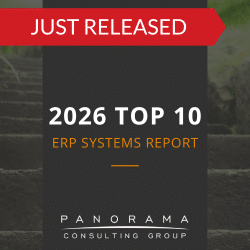In the world of enterprise resource planning (ERP), failure is not a new concept. You may have heard the horror stories—projects that went over budget, implementation timelines that stretched into infinity, and entire systems that simply didn’t deliver benefits.
These stories, of course, aren’t exclusive to any era, but the stumbling blocks of the 1990s look quite different from the ones organizations face today.
So what does ERP failure look like now, compared to its earliest incarnations? While the core challenges—people, processes, technology, and data—remain relatively consistent, how they manifest has shifted.
Today, we’re discussing ERP failure history, exploring the contrasting landscape of ERP challenges then vs. now and taking a closer look at how ERP failures have evolved.
The 1990s: When ERP Was Still an Exotic Beast
The 1990s saw ERP systems rise from obscurity into the spotlight, with promises that sounded almost magical: a single system to manage finance, HR, manufacturing, and an SCM system, all in one place!
Companies, especially large enterprises, were eager to jump on the bandwagon, believing these systems would propel them into the future.
Unfortunately, the learning curve was steep, and the cost of failure was high.
Here are three lessons learned from early ERP failures:
1. Customization and Complexity: A Recipe for Disaster
In the 90s, ERPs were highly complex and rigid systems. This meant that every implementation required heavy customization to meet the specific needs of an organization. As you might imagine, this was like attempting to fit a square peg into a round hole—again and again, with different-sized pegs.
Each customization increased the complexity of the system, making it harder to implement, more expensive to maintain, and almost impossible to upgrade.
Our computer software expert witnesses have been in this arena for decades, and if you mention the 90s, they will bring up stories of countless companies underestimating the amount of work required to tailor ERP systems.
Take, for example, the famous case of Hershey in 1999. In their bid to streamline operations, Hershey decided to implement a new ERP system that included SAP and other software components. The process was so complex and drawn-out that it ended up delaying shipments of candy during the Halloween season—resulting in a major loss of revenue.
This wasn’t just a failure of technology; it was a failure to properly manage the massive customization and change processes required to adapt an ERP to their specific needs.
A Failed Payroll System Implementation
Panorama’s Expert Witness team was retained to provide a forensic analysis and written report to the court regarding the failed implementation of a major software developer’s ERP/payroll system.
2. Budget and Timeline Blowouts: The Classic Tale
If there’s one hallmark of ERP failures in the 90s, it’s the tendency for projects to wildly exceed both budget and time estimates.
Back then, ERP projects were akin to a black hole: once a company was sucked into one, it was difficult to escape without losing massive amounts of money and time. The average ERP implementation took years, with price tags often reaching into tens or hundreds of millions of dollars.
Even high-profile companies weren’t immune to these challenges. In the late 1990s, FoxMeyer, a pharmaceutical distributor, attempted to implement an ERP system to improve its logistics and operations. The implementation, however, ended up costing far more than expected and, combined with other factors, contributed to the company’s eventual bankruptcy.
This was an era where most companies were underestimating the sheer scope of ERP projects. CEOs and executives, blinded by the promises of efficiency, often approved massive ERP budgets without understanding the resource drain these projects would become.
3. People and Processes: Overlooked and Undervalued
Another significant issue with ERP in the 1990s was the focus on technology over people and processes. Companies often saw ERP as a silver bullet—a tool that would automatically fix broken processes or streamline outdated workflows.
Unfortunately, this led to large-scale ERP failures because businesses didn’t adapt their operations to fit the new system and failed to invest in proper training and change management.
During this era, many organizations failed to realize that an ERP system is only as good as the people using it. A prime example of this was the U.S. Navy’s ERP project in the late 1990s. The Navy aimed to overhaul its vast and complex logistics and financial systems, but the initiative encountered massive setbacks. While the technology had the potential to streamline operations, the project suffered from a lack of proper change management and user training. Employees were unprepared to adopt the new system, and the processes in place were not aligned with the new ERP’s capabilities.
Today: ERP Failures Have Evolved, but They’re Still Painful
Fast forward to today, and ERP systems have come a long way. They’re more flexible, cloud-based, and scalable. However, despite this progress, ERP failures still happen, and sometimes with consequences just as severe as those in the 90s.
In fact, some might argue that today’s ERP failures are even more intricate because expectations are higher, timelines are tighter, and the digital landscape is constantly shifting.
Here are some common ERP challenges today:
1. The Complexity of Cloud-Based ERP
One of the major shifts in ERP implementation today is the move from on-premise systems to cloud-based solutions. This brings a host of new benefits—scalability, real-time updates, easier upgrades—but it also introduces new ERP challenges.
While cloud ERP reduces some of the customization problems seen in the 90s, it’s not a perfect fix. The main problem with today’s cloud-based ERP systems is that they still require significant configuration. Companies are sold on the promise of faster, smoother implementations, but then discover that configuring the system to meet their unique needs can be more complex than they realize.
The cloud isn’t a “one-size-fits-all” solution. When companies underestimate the complexity of configuring a cloud-based ERP, they face the same issues that plagued ERP failures of the past—budget overruns and extended timelines.
Furthermore, cloud-based systems rely heavily on data integration from various sources, which adds layers of complexity that weren’t as prominent in the 90s. Now, a failure to integrate the right data sources can cripple an organization, leaving teams frustrated and the system underperforming.
2. The Curse of Overconfidence in Agile and Quick Implementations
The 90s were marked by drawn-out ERP projects that could take years to complete, but today, ERP vendors often promise much quicker implementations thanks to agile methodologies and pre-configured solutions.
Unfortunately, this has led to a new kind of failure: companies now expect lightning-fast results and often rush through critical stages of the project, especially when it comes to change management and proper testing.
While agile development is a great strategy for certain kinds of software projects, it doesn’t always translate well to ERP, which touches every part of an organization. When businesses try to push through an ERP project too quickly, they miss important steps—leading to poor user adoption, inadequate training, and ultimately, failure. Speed, in this case, can be the enemy of success.
A good example of this is the Lidl ERP disaster. The German supermarket giant began implementing a new SAP ERP system in 2011. They tried to move quickly, but their specific needs required complex customizations. By 2018, after spending an estimated €500 million, Lidl abandoned the project entirely because it was simply too complicated and too rushed.
3. People and Processes: Still the Weak Link
While ERP technology has made leaps and bounds, the human element remains one of the biggest reasons for failure. Today’s companies often focus too much on the technological benefits and forget that an ERP is, at its core, a tool to support people and processes.
Without proper change management, training, and a company-wide understanding of the project goals, even the most advanced systems will fail. This is where we see a common thread between the ERP failures of the 90s and those of today: people are still the weakest link.
Whether it’s because companies aren’t dedicating enough resources to change management or because they assume modern, user-friendly interfaces require less training, the people factor remains crucial. If users don’t adopt the system, or if executives don’t sponsor and drive the change, failure is almost guaranteed.
Today, the pace of business is faster, which means that change management needs to be even more proactive. Companies must take a holistic approach to ERP projects, ensuring that they not only have the right technology in place but also the right processes and training to support it.
The Lessons Learned: ERP Failures Then vs. Now
So, what can today’s CEOs and executives learn from the ERP challenges of the past? The evolution of ERP failures shows us that while technology has progressed, many of the core issues remain.
Companies must take a comprehensive approach to ERP projects, considering not just the technology but also the people, processes, and data that underpin it.
Here are three lessons learned from ERP failure history:
1. Invest in Change Management Early
Whether you’re implementing an ERP system in the 90s or today, one thing is clear: organizational change management is critical. Organizations that don’t invest in preparing their people for the new system are setting themselves up for failure. Start early, communicate the benefits, and ensure you have executive buy-in from the beginning.
2. Understand the True Complexity of ERP Projects
ERP systems may have become more flexible, but that doesn’t mean they’re simple. Whether it’s a cloud-based system or an on-premise solution, organizations must understand the full scope of what they’re getting into. ERP implementations touch every part of a business, and underestimating that complexity leads to failure.
3. Focus on the Long-Term Benefits, Not the Short-Term Wins
In the 90s, ERP systems were sold as magic bullets, and today, the same can sometimes be said about agile methodologies or cloud solutions. While the technology has improved, organizations need to focus on long-term benefits rather than rushing to complete the project. Rushing an ERP implementation may lead to short-term wins, but the long-term costs can be astronomical.
ERP Failures Will Continue to Evolve
The evolution of ERP failures is rich with cautionary tales.While companies continue to grapple with the complexity of these systems, they can learn from past failures to better navigate the landscape and achieve success.
Learn from the past and contact our independent ERP consultants today to ensure your ERP journey drives effective, lasting change and positions your company for long-term success.















